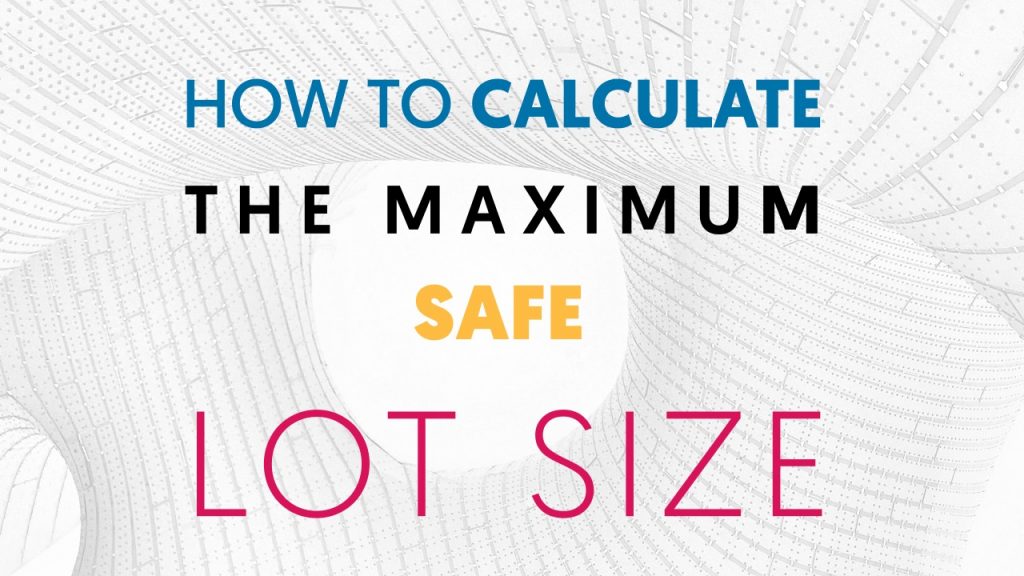
Do you know there’s a safe way to choose the maximum lot size to use, in order to keep your account safe from blowing when a losing streak of trades appears?
I believe you often listen to: don’t risk more than 1% per trade, or 2% per trade, or 5 % per trade, or whatever…
You hear that a lot, right?
So, I guess that you already made these questions to yourself:
- Where do that risk-per-trade values come from?
- What risk per trade should I use?
- Why should I choose that risk value?
After you understand how it’s calculated you can jump to the online lot size calculator and use it yourself.
What if I told you that risking 3% per trade could be safer than risking 1% per trade?
What? Risking 3% is safer than 1%?
It’s possible because you can’t compare that risk % just by themselves and apply that to any trading strategy that you use.
Every strategy is different:
- different win%
- different drawdown
- different maximum number of winning streak
- different maximum number of losing streak
- even the trader is different (making the same trading strategy having different results with different traders)
That’s why you can’t just choose a risk % per trade blindly and apply that to all trading strategies, regardless of your trading style.
There’s not one solution that fits all.
It needs to be calculated according to your history of trades.
If a specific strategy has more consecutive losing trades than another one, you need to trade using smaller lot sizes.
That’s why risking 3% per trade on a particular trading strategy can be safer than risking a lower % on another trading strategy.
Just be careful with the following:
How much should you risk on each trade?
If you are not consistent yet, you should always risk the minimum lot size possible. If you are already consistent just follow the next rules.
How do you choose the best lot size for your specific trading strategy?
I’ll explain this with a real example.
A few years ago I was testing several trading strategies. Some I learned from other people, some I developed myself, and some were a mix of both.
And one of the strategies started to call my attention in particular.
I was scalping GBP/USD every day and after 2 months and 417 trades, I realized I was already 260 pips in profit.
Pretty good for a scalping strategy where I only aimed for 10-20 pips a day and then stopped.
This is the accumulated pips trading curve of that particular scalping strategy:

How much money was I making?
Only a residual amount. I was trading using the minimum lot size (0.01), which means $0.10/pip.
So, overall, I made around $26 in 2 months.
But I was just testing the strategy.
I was not trying to make money yet.
Now I could go for a big run.
At this point, I had a good amount of data that allowed me to analyze the strategy and start to increase the leverage to use a bigger lot size.
And that chart is the only thing I need!
What’s so important on that chart?
The key we are looking for is exactly the maximum drawdown that I had on that particular test period.
The more extended the period, the more confidence you should have in that maximum drawdown.
What’s the maximum drawdown?
The maximum drawdown is as simple as the biggest drop that you see on the accumulated profit chart.
In this example, you can see that at a particular time, I had around 210 pips in profit.
And on the following days, this accumulated profit dropped to 136 pips, before starting to climb again and making a new accumulated profit high.
So, my biggest drawdown was 210 – 136 = 74 pips.
That’s the maximum loss that my account had to survive in order to keep growing healthy.
Since I was trading 0.01 lot size ($0.10/pip), my biggest drawdown of 74 pips was $7.4.
My account was small, $500.
So, that $7.4 loss was 7.4/500×100 = 1.48% of my initial account size.
At the same time, my global total profit was 260 pips = $26 = 26/500×100 = 5.2% of my account size.
In around 2 months I made 5.2% of profit (average of 2.6% per month) with a maximum drop of 1.48%.
How to increase the lot size based on that?
So, basically, you want to know:
How much should you risk per trade?
You need to calculate your risk per trade based on your drawdown. Never use a fixed value without knowing why. When you increase the lot size, you’ll increase the drawdown. You don’t want the drawdown to increase too much, in a way that may affect your ability to trade.
Now it’s just simple math and risk tolerance.
Build a table with the values that you have.
The first line is just the data that you already have from your trading history.
- lot size = 0.01
- profit / month = 2.60%
- drawdown = 1.48%
To get the next lines you just multiply the values that you have on the first line.
For example, to get the values for lot size = 0.02, you multiply the values of the first line by 2, because lot size = 0.02 = 2x the initial lot size.
To get the values for lot size = 0.10, you just multiply the first line values by 10, because lot size = 0.10 = 10x the initial lot size
And you do the same thing for all the other lines.
Here’s the table for my specific example:

How do I use that table?
Now it’s easy.
You should ask yourself: how much drawdown can I handle so that it doesn’t affect my mind and ability to trade?
Let’s say that you don’t want to have a drawdown higher than 30%.
In our example, you could trade using a lot size = 0.20.
That would give you a maximum drawdown of 29.6%.
And you could expect to have an average return of 52% per month.
That’s great, but I don’t use fixed lot sizes. I always calculate the same risk for every trade and that gives me different lot sizes per trade.
No problem at all.
The strategy of my example used a fixed stop loss, so the lot sizes were always the same on every trade.
If your stop loss is not fixed, you just need to change the first column of the table.
Instead of calling it lot size, call it risk %.
So, let’s say that on your trading history instead of using a fixed lot size = 0.01, you were using a fixed risk per trade = 0.10%.
That table would end up like this:

So, to get the maximum 30% of drawdown, you would need to risk 2% per trade.
Conclusion and remarks
You now know how to leverage your lot size with safety without the risk of blowing your account.
Using this technique you can maximize your earnings and at the same time restrict your drawdown to a value that you are comfortable with.
Make sure that you have a nice amount of history trading that strategy.
If you have a small amount of history, the big drawdown may not have appeared yet. The bigger the history, the more confidence you’ll have to increase the lot size.


